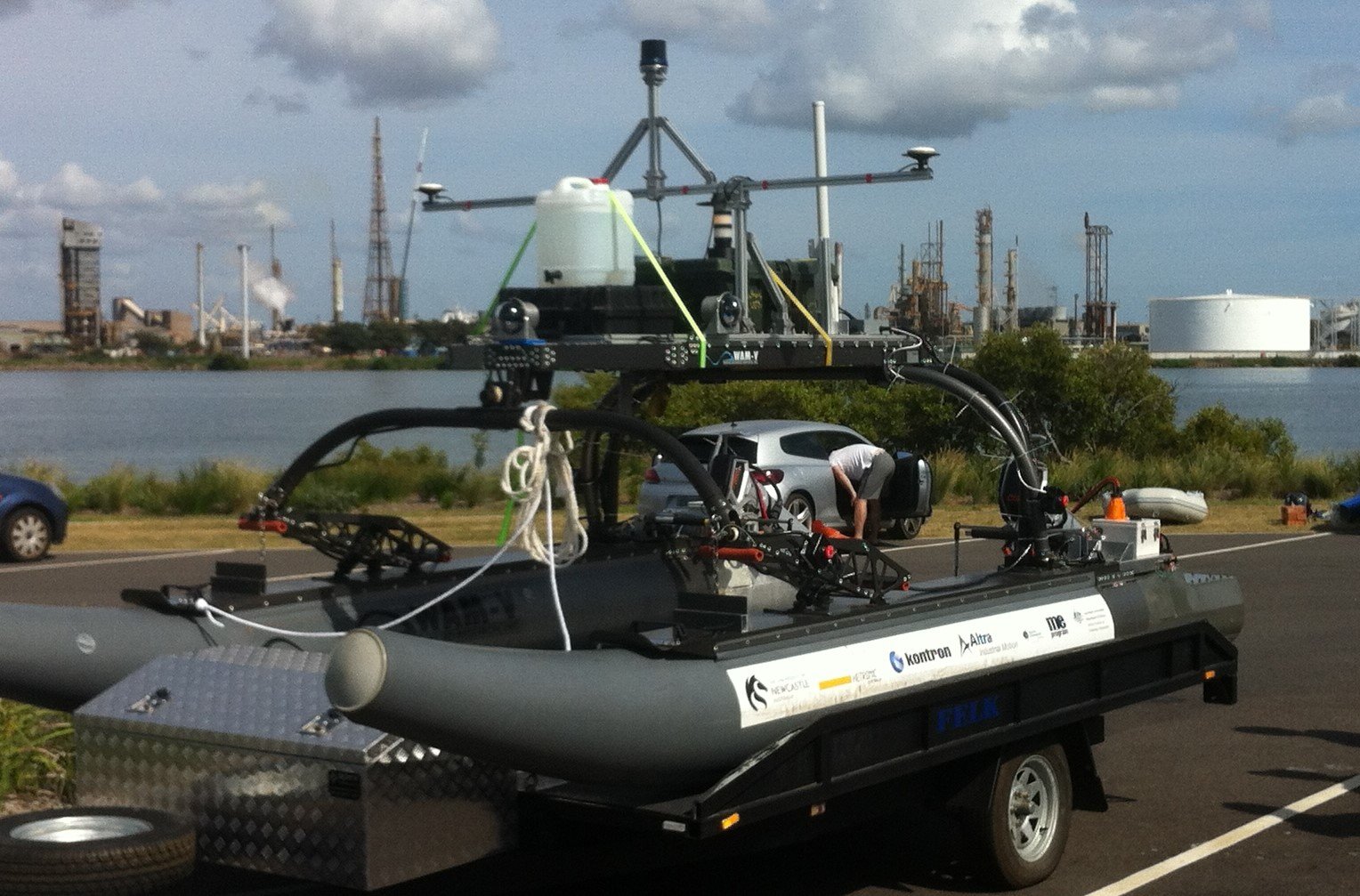Navigation System
The navigation system has the role of informing
the team of the position of the vessel, as well as what the
surrounding environment looks like. It integrates the available
sensors, in this case a LiDAR and GPS/IMU, and uses the
incoming data from these measurements to estimate the state
of the WAM-V and the world around it. An Unscented Kalman
Filter (UKF) is used to manage the measurement updates and
merge these with the mathematical process model that explains
how the WAM-V should move.
The UKF works by representing measurements and the state
of the vessel as Gaussian probability distributions with varying
mean and covariance. It has three main steps: first, obtain the
measurements, then integrate these measurements to update
the probability of the state using conditional probability, and
last, predict the next state of the vessel. The fundamental
process happening inside the UKF is called an unscented
transform. Here, sigma points are formed around the mean
of the input, and these are pushed through their respective
non-linear function. The mean of the covariance of each of
these sigma point outputs is taken and turned into the resultant
probability distribution.
The navigation system, with the help of the UKF, can then
pass on estimates of state and landmark positions in the world
to the other systems for use in their algorithms.

Plotted points returned by the Hesai Pandar-XT32
Vision System
The goal of the vision system is to use the input from the vessel's attached camera
systems
in
order to
identify and help locate different objects in the world, providing crucial knowledge to the system which
will
allow it to complete many of the competition tasks.
The vision model utilises a CNN model known as YOLOv5, an extremely well optimised model used within
many
machine vision applications. The model has been trained on a collection of images and has been
continually
expanded upon as time has gone on, with approximately 3000 images making up the current training
dataset.
In the current configuration, images are read in from each camera at a fixed frequency and processed on
a NVIDIA
Jetson Nano. Each image is run through the detection model and the location of the proceeding bounding
boxes for
each object are recorded. The image is then split into 10 segments, with the segment each
detected object appears in also being recorded. The purpose of this process is to provide as much
information as
possible to the Navigation system in order for the LiDAR to locate the detected objects and generate
accurate
range measurements, allowing for a map of important landmarks to be generated and for a path to be
calculated.
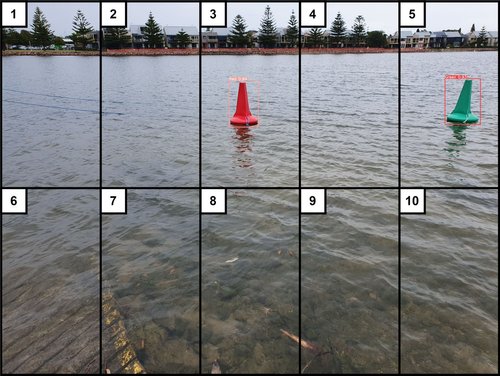
Vision system's processing of incoming images into segments
Power Management System
To power the platforms main hardware,
sixteen 100 AH 3.4V Lithium Iron Manganese Phosphate
(LiFeMnPO4) cells with a bespoke Battery Management System
(BMS) were used. This bank of cells are split up into
2 parallel pairs with 8 cells in each for a nominal voltage
of 26.4V. LiFeMnPO4 was chosen due to their durable, safe
and reliable operation while in the wide range of operational
environments needed.
The BMS incorporates custom made voltage and temperature
monitoring circuits for each cell, current sensing and a
complete active balancing array with internal charging current
sensing. The BMS uses multiple high-end micro controllers
to collate, filter and transmit the data to the rest systems
integrated on the platform.
To achieve accurate active balancing, system identification was
conducted to calculate the Open Circuit Voltage (OCV) and the
total capacity of each cell. This data is also used to estimate a
SOC using a 2 pair RC parallel pair equivalent circuit.
A battery shore monitoring system was created to monitor
graphs in real time of temperature, SOC, and cell voltage while
the WAM-V is in operation.
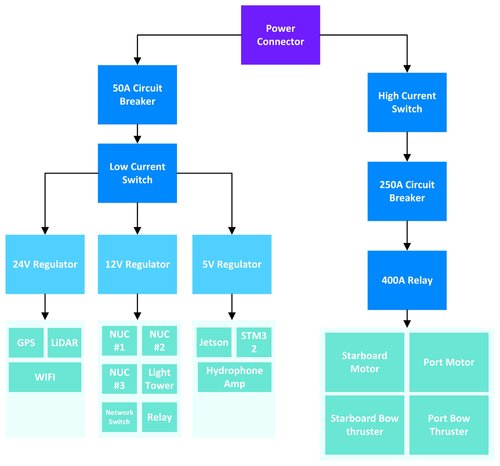
Layout of power system components
Supervisory System
The supervisory system acts as the brain of the platform.
It is responsible for being the translator between the OCS and the ROS network on the boat.
Distributing messages to and from ROS nodes and ensuring each system has the information that it
requires.
The supervisory system is also responsible for flagging and acting on any faults detected on the WAM-V.
Another aspect of the supervisory system is the mission planning algorithm.
The version deployed on the WAM-V takes an input from the OCS specifying what task the platform should
be attempting to execute,
and with this information, interprets feature positions from the navigation node to develop a mission
plan, and pass waypoints to the guidance node.
The mission planning suite is also responsible for resource management and will return to base if it
cannot execute the designated task for any reason,
such as a depleted battery.
Guidance System
The guidance system is responsible for generating
a state trajectory which can meet the mission requirements
communicated by the supervisory system and can be feasibly
achieved by the control system. The guidance solution takes
both the binary occupancy grid map and the mission planning
data as inputs, generated by the navigation and supervisory
systems, respectively. This data is used to generate a collisionfree
trajectory from the current pose to the mission goal via the
D* Lite path planning algorithm, which is a dynamic variation
of the widely implemented A* algorithm. Each obstacle is
inflated by a fixed radius to ensure the WAM-V remains a
conservative distance away from objects on the course.
Key way points are then extracted from the algorithm's path
result and fed into a quadratic programming routine which fits
optimally smooth cubic splines to the path. The quadratic programming
spline generation ensures the reference trajectory is
smooth and continuous, and as such can be reasonably tracked
by the control system. This process is run in real time and
continually updates the path during active missions based on
changes in the map environment.

Top down view of the optimised state trajectory produced by the quadratic
programming solver
Propulsion System
The control solution's purpose is to accurately and efficiently navigate the unmanned
surface
vessel (USV) along a desired path.
To accomplish this, two control schemes were developed for trajectory tracking and station keeping
tasks.
The trajectory tracking controller uses two separate feedback control loops to maintain body fixed
velocity and
earth fixed heading of the boat.
Both control loops use proportional integral derivative (PID) with static gains and an anti-integral
windup to
perform effective tracking of the USV.
The station keeping controller uses three separate PID control loops to effectively maintain the pose of
the
USV. Through the thrust configuration on the boat, the USV can maintain the heading and position on the
water
with external currents and wind imposing disturbances on the system. The three separate control loops
track the
local earth fixed x and y positions along with the earth fixed heading and by using the thruster
configuration
an appropriate thrust output can be determined.
The current position, heading and velocity is received from navigation along with the desired position,
heading
and velocity for the planned path from guidance to correctly determine the given errors for the PID
control
loops. Both controllers were tested within simulations to confirm their feasibility.
A nonlinear model predictive controller (NMPC) was also simulated effectively for trajectory tracking a
planned
path but due to limitations of having accurate models of the WAM-V and thrust profiles of the Torqeedo
motors,
this was simplified to this current model-free solution. With sufficient system identification of the
vessel and
motors, a solution would be able to be produced.
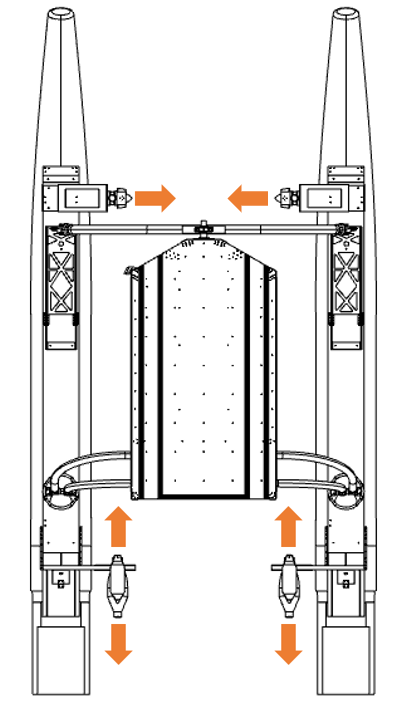
T thrust design configuration used for vessel actuation
Operator Control System
An Operator Control Station (OCS) was developed to communicate with
the vessel from the shore. This device houses a Raspberry Pi 4 attached
to a LED Panel which allows for clean interfacing to and from
the vessel via a user interface. The bridge
between the OCS and the WAM-V itself is created using a pair
of Ubiquity Rocket 5AC Lite base stations linked together in
point-to-point mode, essentially acting as an invisible Ethernet
cable. The OCS serves 3 main purposes:
- To relay and display important information to the team such as GPS outputs, useful plots and even
more
useful error messages.
- To inform the vessel of whether it should be behaving in manual or automatic configuration and to
facilitate
this through either manual input commands from an attached PS4 controller or through competition
task and
waypoint inputs which dictate the behaviour of the onboard autonomy systems.
- To provide remote E-Stop functionality, allowing the team to cut power to the motors from the shore.
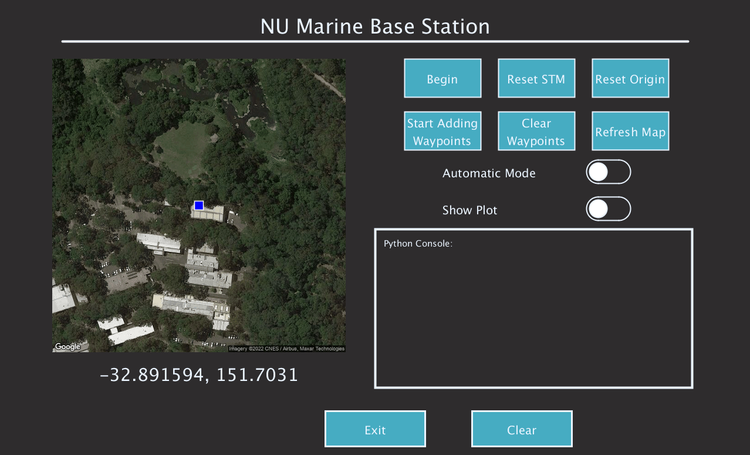
Early version of the team's Operator Control System interface
Safety System
To both comply with competition regulation and
uphold the highest degree of safety, a
designated safety system has been developed. Attached to the vessel are 4 E-Stop switches
that are connected to a shared relay. If one of these buttons
is pressed, a further relay is tripped, blocking power flow
to the motors and adjusting the status light atop the boat
accordingly. Furthermore, connected to E-Stop relay is an
STM32H7 microcontroller, this board is configured to receive
in serial data from the OCS on the shore through a link created
between a pair of RFD900x devices. Within the OCS housing,
a separate STM32F303 is set up to read in a signal from a
fifth E-Stop button, mounted to the housing. If this button is
pressed, a signal is sent across the serial link in under a second,
triggering the relay and mimicking the effect of pressing a
button mounted to the vessel itself.
In addition to this functionality, a consistent frequency “heartbeat”
message is sent across the serial link. If this message is
not received by the vessel for any reason, power is also cut to
the motors, maintaining safe operation of the vessel.
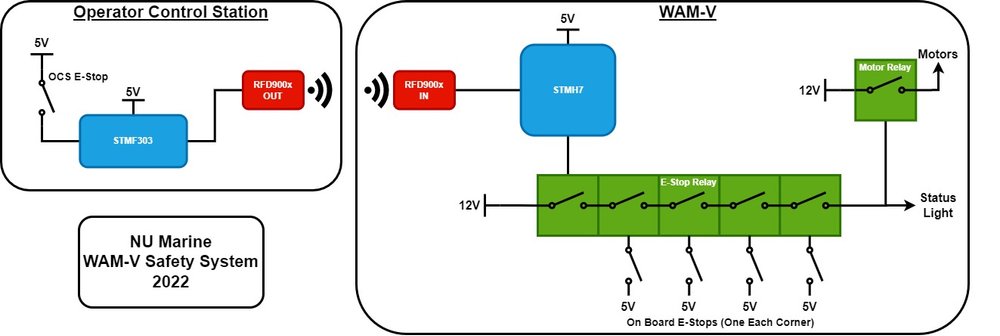
Visualisation of the safety system architecture

